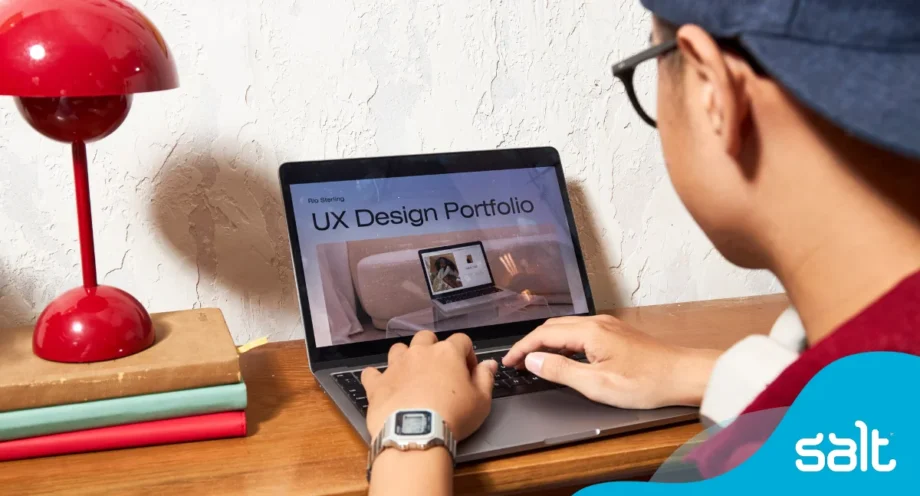What hiring managers really look for in a good portfolio
Jo Corner shares exactly what needs to be in your portfolio. Whether you're a UXer or Graphic Designer, check out these great tips!

Whether you are more of a UXer, Visual Designer, Strategic Designer or User Researcher, your portfolio is your gateway to an interview, the chance for you to showcase what you have done and who you are as a designer.
It can be a daunting and time-consuming task even when the market is booming, never mind in a period of lockdown restrictions and hiring freezes. During this uncertain time, I’ve had several candidates ask me what hiring managers really look for in a good portfolio. So, I asked them.
Here are the highlights from those conversations, some tips for making your portfolio stand out in the crowd, straight from the experts themselves.
Be selective
Across the board, managers said they would rather see a selection of your best and most relevant work, rather than a library of every project you’ve worked on.
Design Manager Ben Crapp advises, “Be wary of having lots of projects all at surface level — instead, focus on 1 or 2 and dissect a bit — what experimentation did you do to get to that point?”
In a similar vein, Product and Experience Design Manager Einav McKennary cautions against adding a link to your Dropbox — “Don’t make me work harder — I don’t need to see 20 designs dating 10 years back — do the work for me, be picky and show the top 2 or 3 in your folio.”
Think about the hiring manager’s experience
It sounds obvious, but remember the high volume of applications the viewer is looking through and make it easier for them.
“Really think about the end-to-end experience you are creating for the hiring manager — what would you encourage them to look at? Signpost the most relevant information and save them time”
Is your folio responsive? Remember, they may be reviewing applications on the go on their phones.
Product & UX Lead Shaun Byrne advises that your thought process should shine through, but in a succinct way. Be aware of TL;DR – “Too Long Didn’t Read.”
Show your process
Be careful about focusing too heavily on polished designs. Hiring managers are far more interested in how you got there
“It’s not just about the execution, I want to see the process, the sketches, who they worked with, what changes had to be made, and how that impacted the outcome; a deep dive into the process.”
Product Design Lead Lauren Burley wants to see candidates dig into multiple solutions which suit the problem — “The working out is 90% of it, even from a UI perspective, what colour did you use and why, what size button worked best, how did you use brand, I want to see all those decisions articulated.”
Give context
If you include a picture, say why! Don’t just add any old photo because you have too much text. Select visuals that are relevant and tell the story of why you are putting something in your folio.
Let your personality shine through
This is even more important in a time of virtual meetings rather than face-to-face coffees. What is your story and how can you shine through your portfolio?
Hiring managers sometimes see dozens of portfolios, and a lot of them look very similar. Be a storyteller and try to highlight what is unique about you, your process, and the work you were involved in, so I would be curious and want to learn more.
“Design is a human role — I want to know who the person is behind the designs, let your personality shine through!” (Shaun Byrne)
UX Research Lead Nilma Perera likes to see an “About Me” section — a short paragraph or phrase that summarises you, who you are, what makes you different from other researchers (or designers). She’s trying to gauge how personable you are and how well you will fit in her team.
Show the impact of your designs
Design Lead Sheree Hannah’s favourite folio had the results of the work the candidate had done, in data, there to see. She says if you can mention conversion rates, how many more visitors a page had after a redesign, or even “this helped the team achieve X”, it will help you stand out.
Be customer-centric
UX Lead Tim Eichler wants to remind candidates that there are a lot of templates out there that start to look “samey”. His advice is to, “Design something that looks like it has been tailored to the problem. Fit to customer rather than cookie-cutter. That stands out far more than if you have just copied what Apple or Uber have done.”
Set the scene well
It’s important to remember the person who is reading it doesn’t know what the problem was you were trying to solve.
UX Lead Tony Jones says, “It’s easy to slip into presenting the outputs without taking the viewer along the way, start with the customer problem and then how you’ve gone about solving it — show a considered, thoughtful approach.”
The stand-out folios are the ones that explain the “why” behind the decisions.
Show the rough with the smooth
UX/CX Lead Andrew Harrison pointed out that the solution may be compromised for many reasons and it is refreshing to see the hurdles and problems documented — “The portfolio should acknowledge the design process itself, which is rarely a neat, smooth process.”
Honesty is the best policy
This is about taking credit for other people’s work. Several managers cautioned against making out that you had more responsibility than you did. Head of UX Lital Sherman says, “It’s important to be honest and be able to back up your work. It may have been a group effort and that is fine — be honest about your contribution.” Melbourne’s design market isn’t that big, don’t risk getting caught out!
Also, be careful not to breach client confidentiality clauses — if they see a product in your portfolio that isn’t on the market yet, it will lower their trust quite quickly and raise the question of how trustworthy you’ll be with their sensitive information.
Categorise as you go
A helpful tip from Ben Crapp will save you time when putting your portfolio together. He suggests, “When you are working on a project, stop from time to time and make sure you are categorising as you go — think about your folio while doing the work.”
Take initiative
Einav McKennary has some great advice for Junior Designers.
If you’re struggling to get experience (and let’s face it, it’s a difficult time for the most experienced designers) choose a product/app you’re not impressed with and redesign it.
“When I was starting out, I didn’t wait for the right opportunity to come along, I looked for an app that wasn’t designed well and redesigned it. I went to a friend who owned a company and offered to redesign their website — it’s a great portfolio opportunity and you can design a product from scratch and show your ideal outcomes without restriction.”
She even suggests you include guerrilla surveys with friends and family, and gain research experience that way.
Consult a mentor
Don’t be afraid to ask for help. Reach out to someone more senior who you trust for some honest feedback about your folio and whether it effectively demonstrates your strengths. There are also some great online resources you can consult, for example, “Founder of The UX Portfolio Formula” — Sarah Doody.
And finally, don’t forget to check your spelling and grammar!
If you’re building a team or looking for work in the Digital Design, UX/UI or Product space, get in touch with our team.


